Geographical Index > United States > Connecticut > Fairfield County > Report # 77112
(Class A)
Submitted by witness Karl S. on Tuesday, March 26, 2024.
Daylight encounter on railroad bed near lower Paugussett State Park
(Show Printer-friendly Version)
YEAR: 1976
SEASON: Summer MONTH: June DATE: 3 STATE: Connecticut COUNTY: Fairfield County LOCATION DETAILS: This happened on the train trax in a wooded area between Rt. 34 and Jordan Hill Rd, east of Newtown, CT. NEAREST TOWN: Stevenson, CT NEAREST ROAD: Rt.34 & Rt.111 OBSERVED: I was 14 or 15 years old. While walking down the railroad tracks on my way to a friends house I was walking between the rails looking down so I didn't trip on the railroad ties. As I was walking I tripped and stumbled about 3 or 4 steps and cought my balance. When I looked up I see about 100 to150 ft. in front of me this dark brown figure about 8-9 ft tall.
It looked at me and turned and in about 3 or 4 steps ran off the tracks and up a small cutaway about 12 ft high and into the woods it went. I was able to tell it was not a bear. This thing was 8-9 ft tall, dark brown hair about 4-5 in. long covering its entire body. It had a basketball player build but with more substance. It had arms that hung down between its knees and hips, but also long legs, The head sat on shoulders aprox. 3 ft wide. The head looked small for the size of the body. I could'nt see any ears or face details, except it was flat.
This thing was fast! I only saw it for about 6 seconds before it ran into the woods. I couldn't see any skin color, only dark brown or black fur. When it turned and ran you could see the reddish tinge of the hair in the sunlight. ALSO NOTICED: It made no noise and didn't really look all that intrested in me. OTHER WITNESSES: No OTHER STORIES: Yes, about 20 years prior listed on the BFRO sight there was a sighting in Shelton, CT. in the Mapels section, of a few kids seeing a large hairy bigfoot type of being walikng along the same tracks as i saw it on just a couple miles south of my sighting. [BFRO Report 16408] TIME AND CONDITIONS: This happened in the early afternoon. ENVIRONMENT: This area is a wooded cut thru for RR Tracks. No houses, with a creek running on its side.
Follow-up investigation report by BFRO Investigator Matthew Moneymaker:
I spoke extensively with this witness. He is a retired police officer and lifelong resident of this area -- very credible. He definitely saw a sasquatch at this location in daylight back in 1976.
This report is not recent but it is important due to the location, and how the location connects to a few other reported encounters, some more recent, and track finds and distinct vocalizations in the Housantonic Watershed around Paugussett State Park, extending back to at least 1953.
The biggest town in the middle of this area is Newtown, Connecticut, which has roughly 26,000 inhabitants, mostly well outside the town center. By Connecticut standards this is a sparsely populated area.
When you click on these images you will see larger versions that make it easier to zoom in.
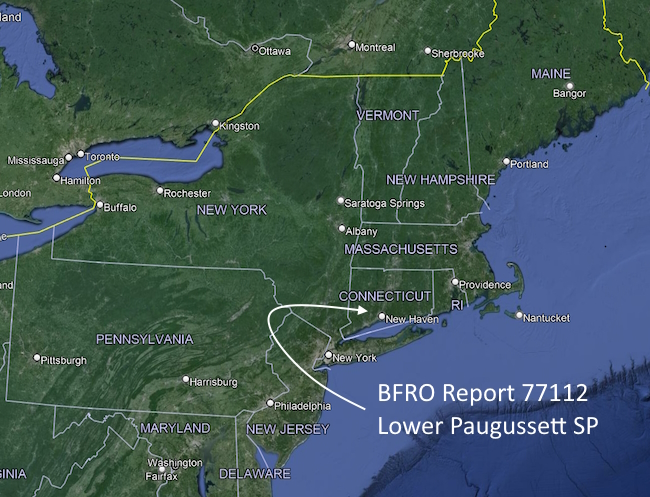
Upper Paugussett State Park is 23 crow miles northwest of Yale University.
It is the closest sasquatch habitat area to Yale that is probably occupied almost continuously by one or more small family groups of semi-nomadic sasquatches year-round.
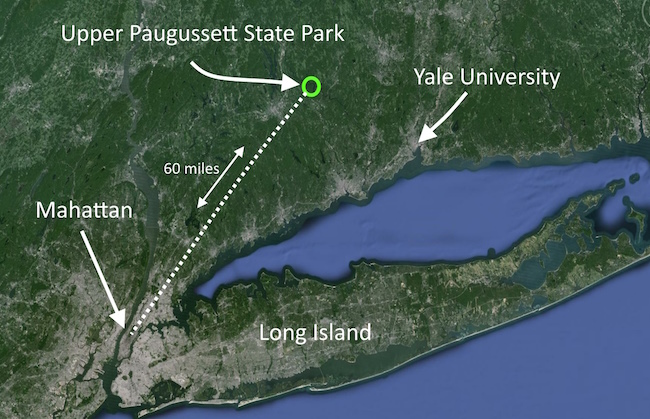
Down the line, when Yalies eventually decide these unique and very intelligent non-human primates deserve some academic attention and long-term study, this area will be the easiest place for them to do it. They won't have to fly out to the Pacific Northwest to study these creatures. There are likely a few dozen of them dispersed along the length of the Housatonic Watershed from its headwaters down to within 8-9 crow miles of the ocean.
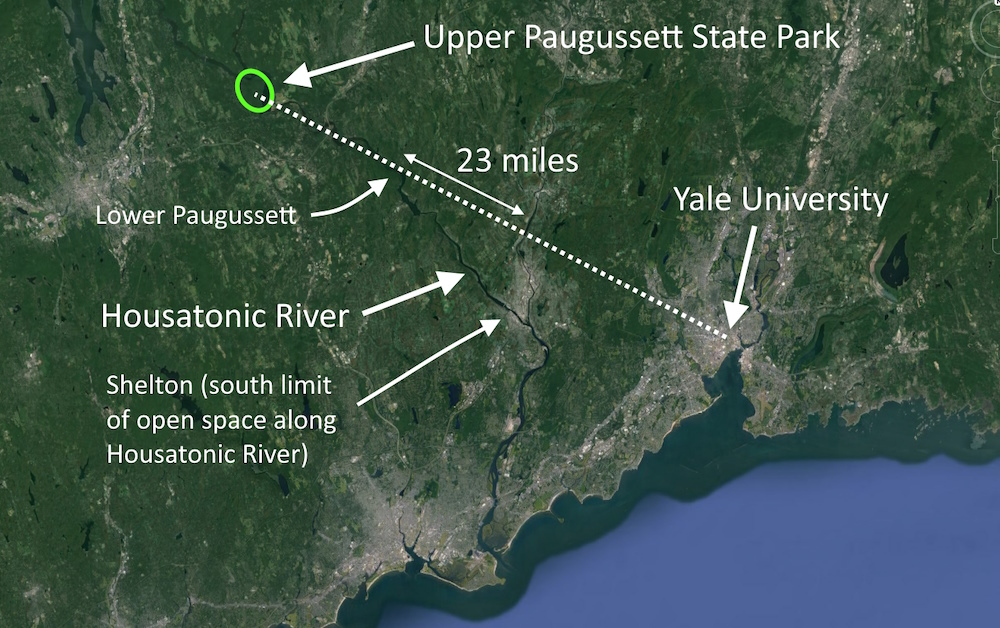
I have some helpful ideas where seasonal nests can be found around this area. Seasonal sasquatch nests will provide the opportunity for both DNA collection (shed hairs) as well as opportunities for will concealed camera placements. There is no other way to study these creatures intimately in their natural state over a long time period of time. Anything more intrusive could easily trigger them to relocate to one of dozens of other suitable strongholds further north along the Housatonic River watershed.
The clearest pattern of sightings in Connecticut is within five miles of the Housatonic River. Sasquatches can inhabitat the large pockets of forest along that river along most of its length, from the top all the way down to just north of Shelton, which is roughly 7 crow miles from the shores of Long Island Sound.
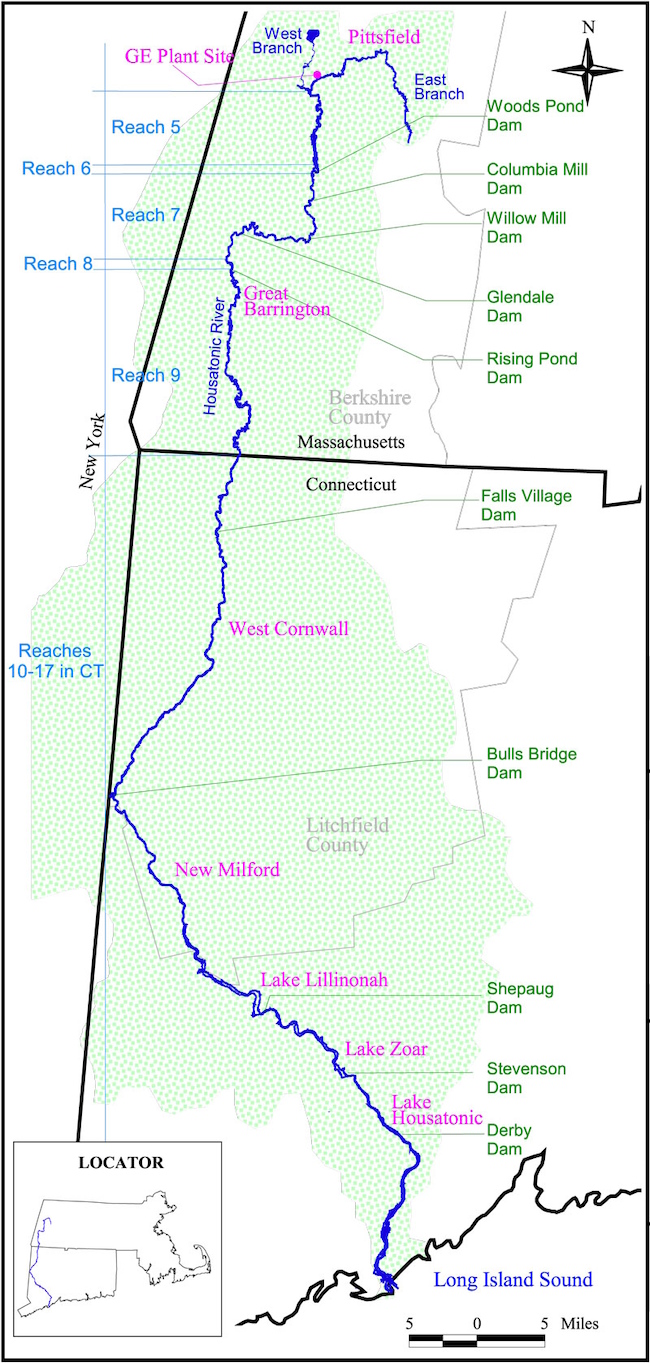
The Appalachian trail connects to the Housatonic River a mere 12 miles northwest of Upper Paugussett State Park.
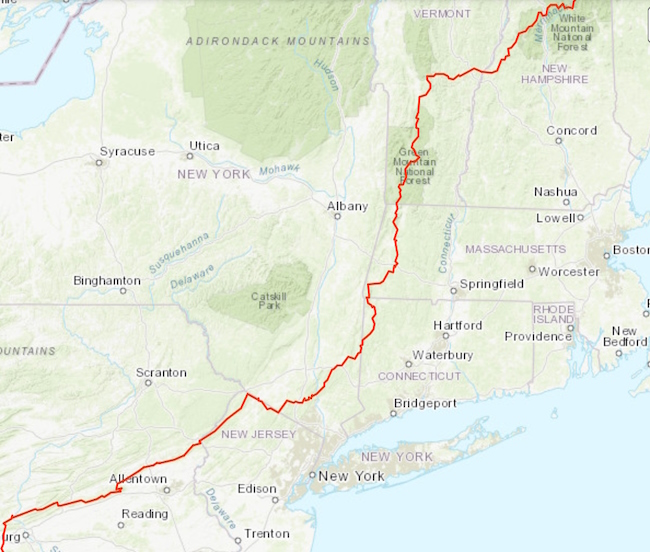
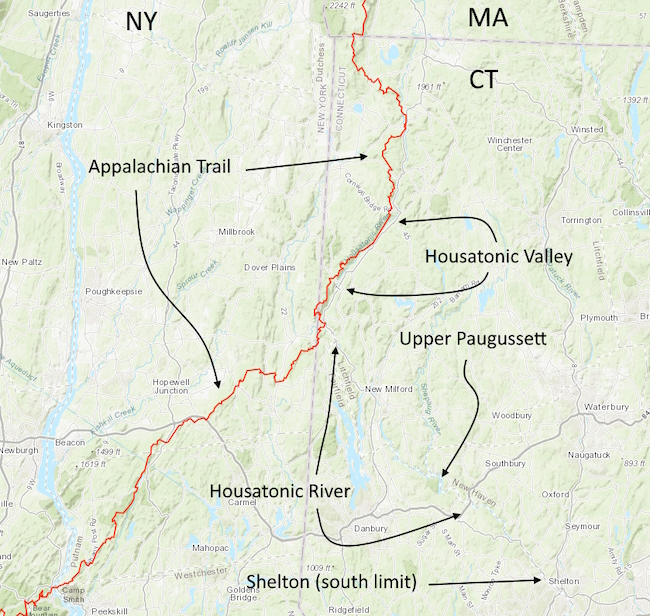
The local pattern of reports around Newtown suggests that at least one small group sasquatches moves through the area along abandoned railroad beds and powerline cuts, just like they do in many parts of the country.
In the case of Connecticut, with all of its dispersed and widely spaced sub-divisions, it would be particularly important to follow powerline cuts and railroad beds because wandering sasquatches could get easily lost and boxed in by housing areas if they wandered too far away from those unobstructed travel routes.
These routes are also favored by deer herds on the move.
You can quickly access the other reports noted in the map below by going to the BFRO's report database for Fairfield County, Connecticut.
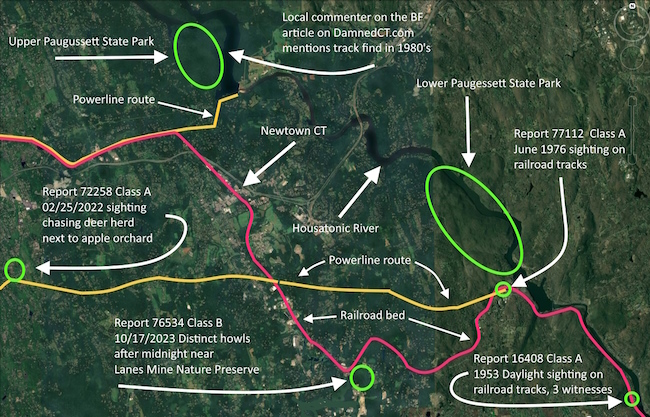
The places to look for seasonal nests would be low spots with dense thickets of pine, particulary red cedar (a species of Juniper).
In regions with no caves or steep deep gullies that would allow them to escape the freezing winter winds, sasquatches will seek shelter in dense pine or cedar thickets. In those places the freezing winds will blow over the top of dense copy.
If the pine/cedar thicket is wide enough there will be crawl tunnels connecting to dry cave-like pockets with piles of pine needles or cedar duff. Sasquatches will make nests on those piles throughout the year, and cover themselves in that bedding in extreme low temperatures. If the bedding is cedar then it has the additional benefit of repelling mosquitoes, ticks and fleas. If the sasquatch crawls into a cedar nest with those bugs already attached to its fur, the cedar oil on the bedding material will kill them on contact. That is very useful in a region where Lyme disease from tick bites is still prevalent.
The image below shows some smaller red cedars (Juniperus virginiana). Under these dense bushy trees, snow and ice and most of the rain will not reach the ground in the cavities around the tree trunks. If utilized by sasquatches, the nests will be deep enough into the thicket to keep out of strong freezing winds around them. Finding the sasquatch nests in this area will likely require crawling through brush tunnels in these thickets.
These trees typically grow 15-20 tall, but can reach 50 feet tall.
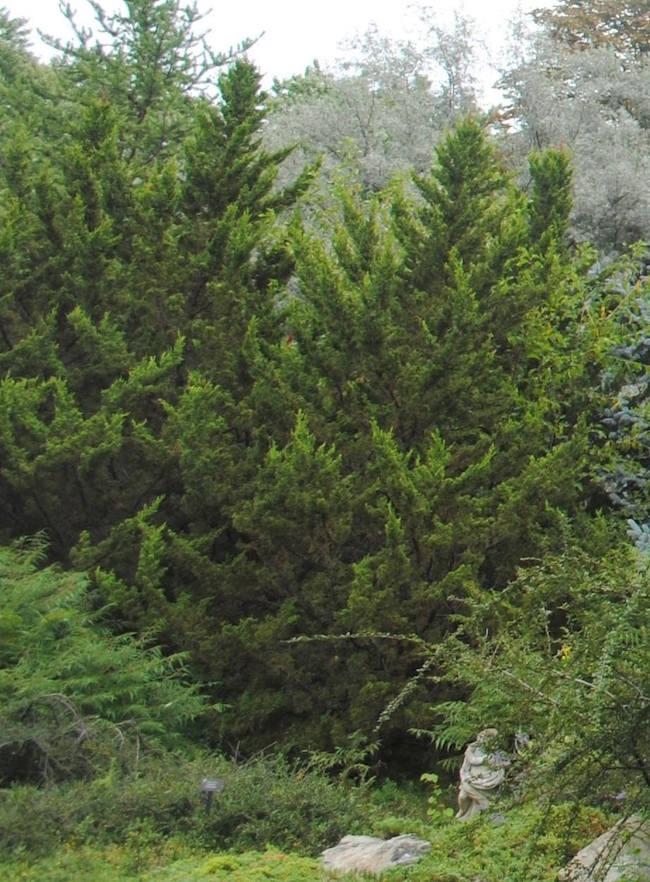
Areas with red cedar thickets or dense pine thickets are not well marked on any maps. The only way to spot them without a lot of footwork is by examining aerial images and topo maps. Look for them while referencing a map of prior incidents and likely travel pathways (like the one shown above).
The "Time Machine" tool in Google Earth allows you to find prior aerial images of this area obtained in the cold months when the leaves are down on the hardwood trees. In those conditions the thickets of pine and cedar will stand out clearly.
If I lived around there I would be first be looking for nests in the dense pine / cedar areas on the river-facing slopes and terrain shelfs of both Upper and Lower Paugussett State Park, which are a few miles apart along the Housatonic.
One practical reason for sasquatches spending most of their time in these areas during the winter: From these areas they would be able to hear and reply to sasquatch howls echoing down along the gorge of the Housantonic River.
On this part of the Housatonic there are a few damns, in between those damns the river creates a few long lakes -- Lake Lillinonah, Lake Zoar and Lake Housatonic. Those lakes are all just long slow sections of the Housatonic River. Loud siren-like sasquatch howls ("Ohio howls") will echo down that valley and reflect across the flat calm waters of these lakes for miles, and up the lake-like Shepaug River valley, especially in the wee hours when the air is very still.
Their howl sounds might be audible to the few humans with homes or cabins facing those lakes, but they would not be loud enough to wake people up in the wee hours. Their reply howls would be emanating from an area with no homes around for 1-2 miles.
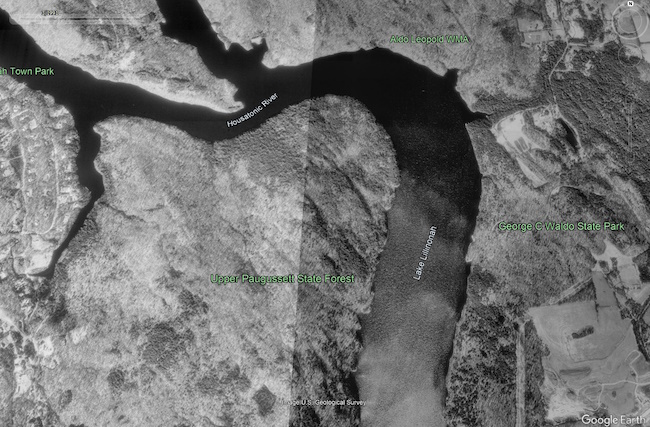
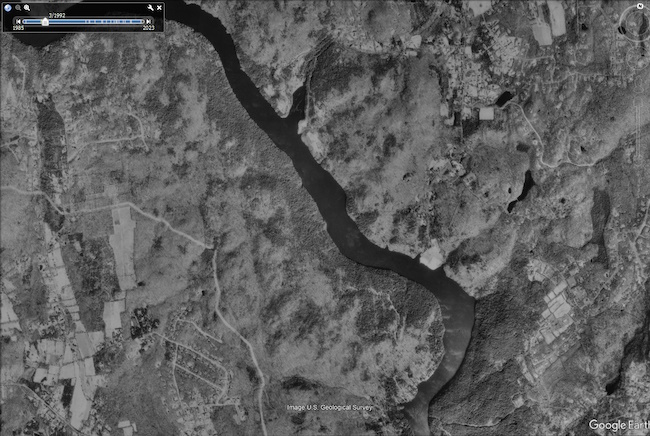
Among those places of dense trees that stay green through winter, the low lying areas that would produce densest thickets of red cedar will often be marked with marsh symbols on USGS topo maps.
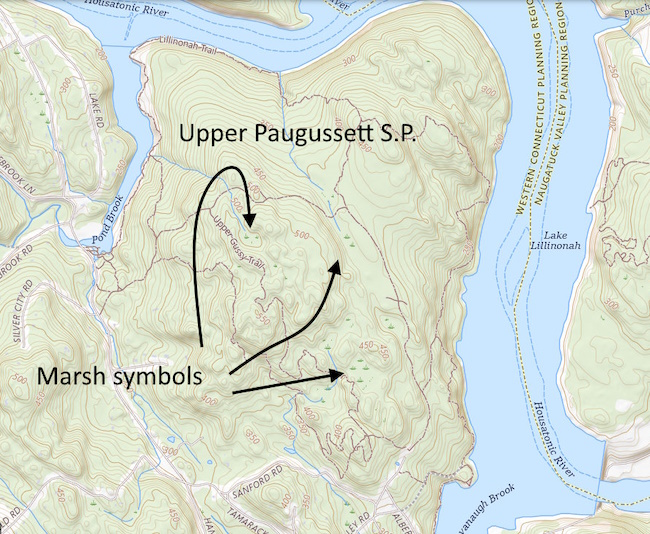
Another very useful tool for identify dense pine and cedar thickets is Landsat Infrared imagery. The thickets stand out much most distinctly in these images (see examples below).
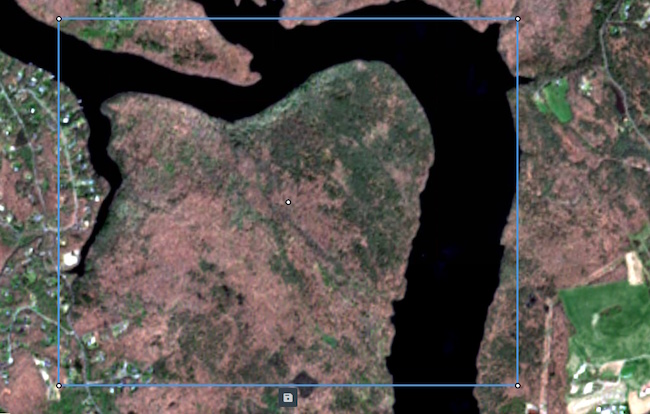
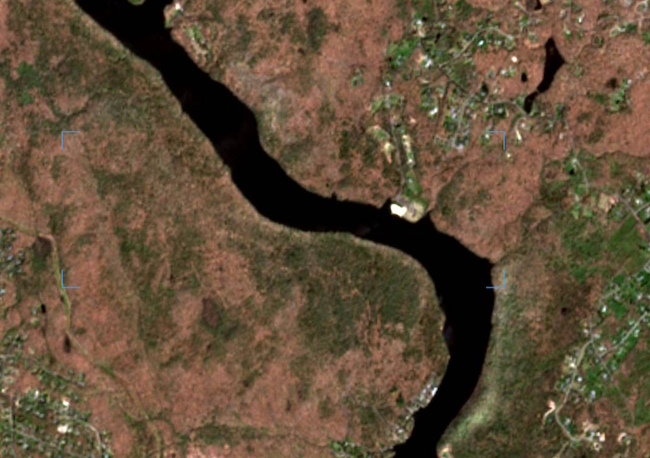
Here is what it looks like on a trail under those canopies.
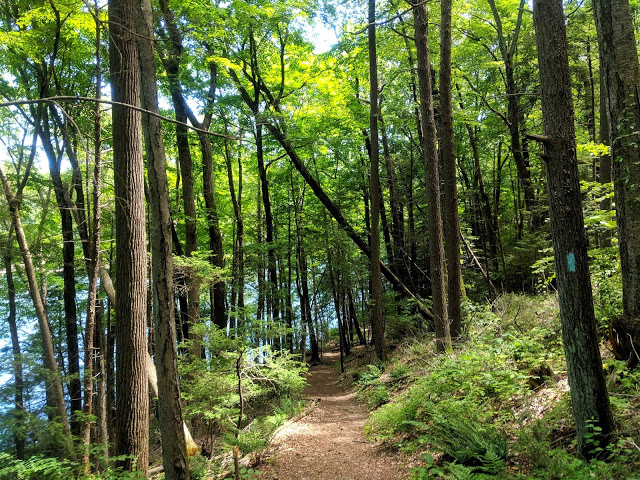
Venturing out from the likely strongholds in the two Paugussett State Parks by following powerline cuts and the railroad bed, sasquatches could access many undeveloped forest zones with deer herds and forage. Considering the speed at which sasquatches cover ground with their steady walking pace (comparable to a fast jog for humans), they could range out ten miles west from Lower Paugussett all the way over the orchards outside Bethel in one night by following a powerline cut.
About BFRO Investigator Matthew Moneymaker:
Matthew Moneymaker is originally from the Los Feliz District of Los Angeles, California.
- Bachelor of Arts in English Literature from the University of California at Los Angeles (UCLA).
- Juris Doctorate (Law degree) from University of Akron School of Law
- Founder of the Bigfoot Field Researchers Organization,1995.
- Writer and co-producer of the Discovery Channel documentary "Sasquatch: Legend Meets Science", 2001.
- Co-producer of the TV Series "Mysterious Encounters" for the Outdoor Life Network (OLN Channel), 2002.
- Producer of the "2003 International Bigfoot Symposium" (Willow Creek Symposium) DVD set, 2004.
- Co-host of "Finding Bigfoot" on Animal Planet Channel, 2010 - 2017.
- Current Director of the BFRO
- Available for private bigfoot expeditions and conferences. To inquire please email ContactUS@BFRO.net

|



































